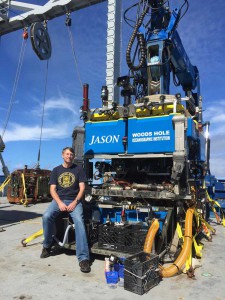By James White
On Friday (New Zealand time), R/V Roger Revelle sailed from Auckland and we’re on our way to Havre Seamount to make seafloor observations and take samples from this newest known submarine volcanic deposit. This is my third trip, widely spaced over two decades, to study deposits of volcanic eruptions on the seafloor, but my first in which the team will deploy a remotely operated vehicle (ROV). It will also be, by a wide margin, the youngest eruption deposits that I will have seen on the seafloor.

James White on deck with ROV Jason.
My first trip, in 1995, was led by a scientist named Rodey Batiza and was among the earliest to employ the submersible Alvin to conduct a focused study of physical eruption processes. We made nine dives on that trip onto a small area of a volcano called Seamount Six to look at and sample a deposit type called “hyaloclastite,” which is made predominantly of small, angular chunks of basaltic glass only one or two millimeters across. Among these miniscule glass fragments are a small proportion of particles broken from very thin glass sheets, which were bent and twisted as they formed. The aim of the cruise was to test the predictions of a model from Rodey’s previous work that suggested these glass sheets are solidified remnants of fluid basaltic magma that was torn apart in submarine lava fountains.
To test this, we looked for the distinctive features of lava-fountain deposits on Hawaii, which are progressively thinner and made of smaller particles at greater distances from the fountain. These deposits also have an elliptical shape when viewed on a map and are elongated in the direction that the wind was blowing during the eruption.
Seamount Six deposits are estimated to be about 2 million years old, but the glassy particles are very fresh beneath, and partly held together by, a centimeters-thick layer of seafloor manganese, which looks like bulbous black moss or mold covering the deposits.
What we found over the course of nine Alvin dives was not what we anticipated. Instead of deposits that became thinner and composed of smaller particles at greater distances from what we inferred to be the source of the lava fountain at the top of the volcano, we found many small patches of deposits, all with about the same thickness and composed of roughly similar-sized grains, over distances of more than a kilometre. This told us that the deposits could not have been formed and dispersed from a single lava fountain.
We then looked for evidence of small lava-fountain sources, particularly small cones of “spattered lava in or near the individual deposit patches, but found none of these, either. Everybody agreed that the most likely origin for all of the blocky glass fragments forming 90 percent or more of the material in the deposits was quench-shattering of hot lava as it cam in contact with cold seawater, but we had no source for the small proportion of small glass sheets that were curved and twisted, even folded, that we thought came from lava fountains.
In one of our many interesting discussions, we realized that these small glassy sheets had a lot in common with much larger, but still very thin and glassy, sheets of basalt that form along the coast at Kilauea where water gets trapped in lava. The trapped water expands as it boils, blowing big bubbles, or balloons, of basalt that pop to form the thin glass sheets. Volcanologist Ken Hon named these formations limu o’ Pele when he wrote about the activity and described how they formed. Deep-sea limu are much smaller than those found on the coast because the great water pressure at Seamount Six depths (1700 to 2000 meters) prevented the boiling water trapped in its basalt bubble from expanding very much at all. It was an interesting and unexpected outcome of my first trip to the ocean floor, and I immediately began trying to arrange another submarine project.
My second trip was over a decade later, in 2006, and was led by Bruce Houghton, who had joined the University of Hawaii from New Zealand just as Rodey left Hawaii for a new position on the mainland. Bruce, a PhD student I was supervising in New Zealand, and I made series of dives with a different small research submarine, Pisces IV, operated by the Hawaii Undersea Research Lab, onto the surface of Loihi seamount. Loihi is the youngest Hawaiian volcano lies lies underwater a few tens of kilometers southeast of the Big Island’s Kilauea volcano. On that cruise, we revisited seafloor deposits where another volcanologist, Dave Clague, had described layered outcrops of volcanic particles that found in small hills built on top of Loihi. Our aim was to sample the outcrops very systematically and then look at the internal textures of the particles to determine how the deposits formed. Rebecca Carey, the cruise co-chief scientist for the Havre expedition we are on now, also took part in the dives.
In one deposit on Loihi, we found more limu associated with a very thin lava flow, but the main samples we took were bubbly basalt glass fragments a few centimeters across. By measuring the volume, shapes, and sizes of the bubbles in different fragments; examining the shape of small grains with a scanning electron microscope; looking at the shapes of tiny crystals; and analyzing the chemistry of the glass, the crystals, and of small blebs of glass that had gotten trapped inside crystals as they grew before the eruption, my student Ian Schipper was able to determine that different small hills were cones from different eruptions. He also showed how the different eruptions behaved, and that, for at least one of, them magma-water explosions must have broken up the erupting magma. The Loihi deposits don’t have thick manganese layers, and are generally much fresher than those at Seamount Six, and, though we don’t know the deposit ages, it is inferred that these deposits are young—perhaps hundreds to a few thousands of years old considering how quickly Loihi has been growing—and much younger than at Seamount Six.
This trip we’re on now to Havre will be a great adventure, but if I hadn’t had the opportunity to study those other submarine volcanoes, I doubt I would be here. There are not a lot of physical volcanologists who study submarine volcanoes, and there have been very few submarine eruptions that we know of historically. This isn’t because there are very few eruptions–in fact, most of Earth’s volcanic activity occurs underwater—it’s because the ocean is vast and seawater covers these volcanoes obscuring eruptions from us on the surface, even if someone is in the vicinity.
The story elsewhere on this site, about how people found out about the Havre eruption, provides a great illustration of how different it is to study submarine volcanoes compared to those on land. And now, after I’ve worked with a 2-million-year-old deposit, and one perhaps only hundreds or thousands of years old, I’ll finally get to look at a fresh one, from an eruption that we know quite a bit about already. This time, however, we won’t be collecting samples from a, so I won’t get another visit to one of Earth’s least-visited realms, but the ROV is much more efficient. Watching the big screens from the ship’s control room will actually provide a better view than you get “live” looking out of the portholes of a research submarine—plus you don’t have to hold your bladder for six or eight hours!








